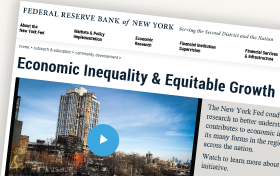Attached are materials related to the actions of the Federal Reserve Bank of New York (“New York Fed”) in connection with the Barclays-LIBOR matter. These include documents requested by Chairman Neugebauer of the U.S. House of Representatives, Committee on Financial Services, Subcommittee on Oversight and Investigations. Chairman Neugebauer requested all transcripts that relate to communications with Barclays regarding the setting of interbank offered rates from August 2007 to November 2009. Please note that the transcript of conversations between the New York Fed and Barclays was provided by Barclays pursuant to recent regulatory actions, and the New York Fed cannot attest to the accuracy of these records. The packet also includes additional materials that document our efforts in 2008 to highlight problems with LIBOR and press for reform. We will continue to review our records and actions and will provide updated information as warranted.
An important and longstanding role of the New York Fed Markets Group is to monitor a wide range of markets for the purpose of understanding and reporting on market conditions and market functioning. Each day, analysts gather information on a nearly continuous basis by speaking with market participants and asking both general and specific questions about prevailing market conditions, the magnitude of movements in prices or the volume of activity, or any other issues in the markets. These analysts also review large amounts of market commentary they receive via individual and mass-distribution emails, and review a wide variety of data feeds.
Following the onset of the financial crisis in 2007, markets monitoring played a critical role by identifying the nature and location of rapidly mutating financial stress. Markets Group analysts engaged with market participants – including staff at Barclays - to better understand the nature of market stress. In the course of these exchanges, market participants reported dysfunction in the form of illiquidity and anomalous pricing across many different markets.
Among the information gathered through markets monitoring in the fall of 2007 and early 2008, were indications of problems with the accuracy of LIBOR reporting. LIBOR is a benchmark interest rate set in London by the British Bankers Association (“BBA”) under the broad jurisdiction of the UK authorities, based on submissions by a panel of mostly non-US banks. The LIBOR panel banks self-report the rate at which they would be able to borrow funds in the interbank money market for various periods of time. As the interbank lending markets dried up these estimates became increasingly hypothetical.
Suggestions that some banks could be underreporting their LIBOR in order to avoid appearing weak were present in anecdotal reports and mass-distribution emails, including from Barclays, as well as in a December 2007 phone call with Barclays noting that reported “Libors” appeared unrealistically low.
As market strains intensified in early 2008, to better understand the nature and extent of the potential problems with LIBOR, analysts in the Markets Group gathered additional and more in-depth information. As part of this broad effort, on April 11, an analyst from the Markets Group queried a Barclays employee in detail as to the extent of problems with LIBOR reporting.
The Barclays employee explained that Barclays was underreporting its rate to avoid the stigma associated with being an outlier with respect to its LIBOR submissions, relative to other participating banks. The Barclays employee also stated that in his opinion other participating banks were also under-reporting their LIBOR submissions. The Barclays employee did not state that his bank had been involved in manipulating the rate for its own trading advantage. Immediately following this call, the analyst notified senior management in the Markets Group that a contact at Barclays had stated that underreporting of LIBOR was prevalent in the market, and had occurred at Barclays.
That same day - April 11, 2008 - analysts in the Markets Group reported on the questions surrounding the accuracy of the BBA’s LIBOR fixing rate in their regular weekly briefing note. The briefing note cited reports from contacts at LIBOR submitting banks that banks were underreporting borrowing rates to avoid signaling weakness. In accordance with standard practice for briefing notes produced by the Markets Group, this report was circulated to senior officials at the New York Fed, the Federal Reserve Board of Governors, other Federal Reserve Banks, and U.S. Department of Treasury. The briefing note is included in this packet.
Five days later, the first media report on problems with LIBOR emerged. From this point onwards the notion that banks were underreporting LIBOR in order to avoid signaling weakness was widely discussed in the press and in market commentary.
In late April and into May 2008, New York Fed officials met to determine what steps might be taken to address the problems with LIBOR. The New York Fed also acted to brief other US agencies. On May 1 Tim Geithner, then President of the New York Fed, raised the subject at a meeting of the President’s Working Group on Financial Markets (“PWG”), a body that comprised the heads of the principal regulatory agencies in the US, chaired by Treasury. On May 6 New York Fed staff briefed senior officials from the U.S Treasury in detail.
On May 20 the Markets Group sent a further report on problems with LIBOR to the broad set of senior officials who receive its regular analysis. The report is included in this packet. On June 5, New York Fed officials also briefed an interagency working group comprised of staff from the PWG. The presentations given to Treasury and to the PWG staff are included in this packet.
New York Fed officials also met with representatives from the British Bankers Association to express their concerns and establish in greater depth the flaws in the LIBOR-setting process. The New York Fed analysis culminated in a set of recommendations to reform LIBOR, which was finalized in late May. On June 1, 2008, Mr. Geithner emailed Mervyn King, the Governor of the Bank of England, a report, entitled “Recommendations for Enhancing the Credibility of LIBOR.”
Among the recommendations were specific proposals to improve the integrity and transparency of the rate-setting process, including the suggestion that LIBOR submissions should be subject to internal and external audit of the accuracy of the reporting by banks. A copy of this email and the memorandum is included in this packet.
Shortly afterwards, Mr. King confirmed to Mr. Geithner that he had transmitted the New York Fed recommendations to the British Bankers Association soon afterwards. After putting forward recommendations for LIBOR reform to the UK authorities, the New York Fed continued to monitor for problems related to LIBOR.
As is clear from the work culminating in the report to Mr. King of the Bank of England, the New York Fed helped to identify problems related to LIBOR and press the relevant authorities in the UK to reform this London-based rate.
|
New York Fed Materials
|
All files in PDF format ![]()
Explanatory Note
April 11, 2008: MarketSOURCE Weekly Market Review
May 6, 2008: Slide Deck of Presentation to U.S. Treasury, "Recent Developments in Short-Term Funding Markets"
May 20, 2008: MarketSOURCE report “Recent Concerns Regarding LIBOR’s Credibility”
June 1, 2008: Timothy F. Geithner e-mail to Mervyn King, copying Paul Tucker, with attached “Recommendations for Enhancing the Credibility of LIBOR”
June 3, 2008: Mervyn King e-mail to Timothy F. Geithner
June 5, 2008: Slide Deck of Presentation to the Interagency Financial Markets Group Meeting "Market Concerns Regarding LIBOR"
|
Materials provided by Barclays
|
Redacted by Barclays
All files in PDF format
August 28, 2007: mass distribution e-mails:
- 8:01 a.m. mass-distribution e-mail from Barclays.
- 11:27 a.m. “reply all” response to the original e-mail from Barclays.
September 26, 2007: mass distribution e-mail Barclays
October 3, 2007: e-mail from Barclays
November 29, 2007: mass distribution e-mail from Barclays
December 17, 2007: transcript of phone call between Barclays and New York Fed Markets Group analyst
March 27, 2008: mass distribution e-mail from Barclays
April 11, 2008: transcript of phone call between Barclays employee and analyst in the Markets Group of the New York Fed
October 10, 2008: transcript of phone call between Barclays employee and analyst in the Markets Group of the New York Fed
October 24, 2008: transcript of phone call between Barclays employee and analyst in the Markets Group of the New York Fed
October 27, 2008: transcript of phone call between Barclays employee and analyst in the Markets Group of the New York Fed












